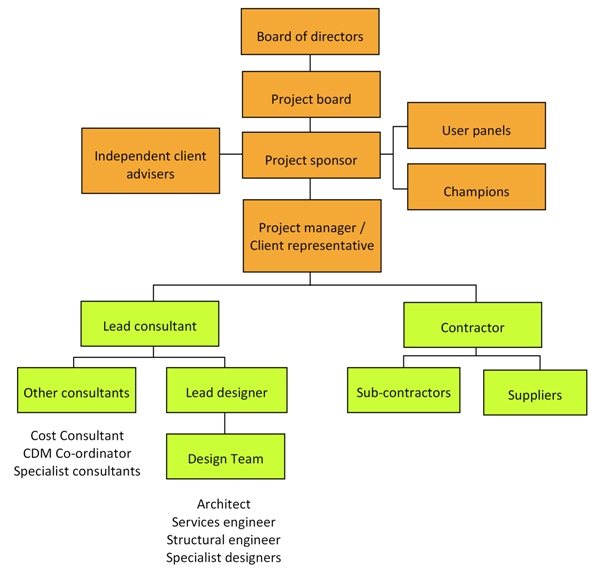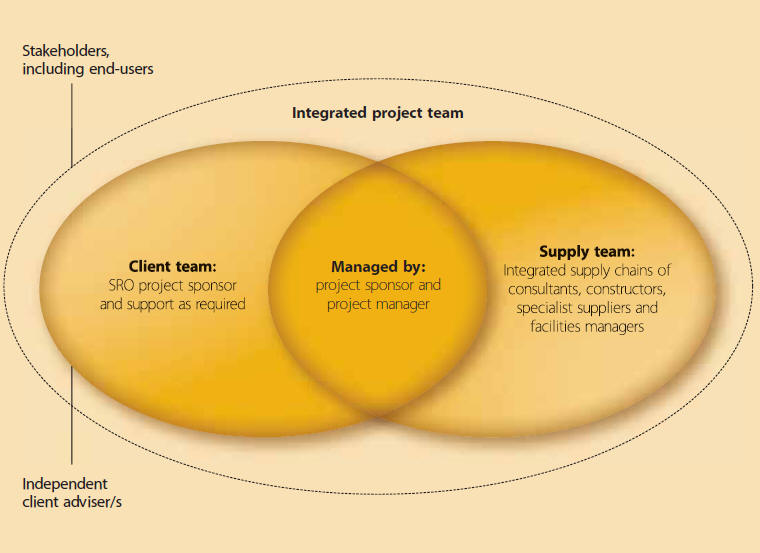Project team for building design and construction
Contents |
[edit] Introduction
Projects to design and construct buildings can involve large numbers of people, and on major projects many thousands of people. The structure and composition of the project team tends to change through the duration of the project; some team members might only have a very brief involvement, bringing specialist knowledge or supplying specialist components during a particular phase, whilst others, such as the client, project managers or lead consultants may be involved for many years.
[edit] Structure
It is crucial that project teams are structured properly from the outset, and that team members are selected carefully to give the project the best prospect of success. However, as there is often some doubt about whether a project will actually proceed during the very early stages proper attention is not always given to defining the project team.
The composition of the project team may change through the duration of a project and may include many members, but an indicative, outline structure for a traditional project is shown below:
See the article: Consultant Team, for a full list of the consultants that might be involved in a project.
It is important that roles, responsibilities and reporting mechanisms are clearly defined in appointment documents and communicated to other project team members. In addition, where project team members are accepting risk for delivering part of the project, this must be properly understood and defined (for example, planning risk on design and build projects).
A roles and responsibilities matrix can help identify the roles required, what actions individuals and groups will need to take, whether there are any gaps, and what additional resources may be needed to complete the project. An assessment can then be made as to whether any required resources exist within the current organisation or whether new appointments will be required. As the project develops, a responsibility assignment matrix can be created to set out in more detail which specific tasks are assigned to which individuals.
[edit] Collaborative practices
Successive reports about the UK construction industry have described it as fragmented and adversarial, with a tendency to adopt a single-discipline mentality, not in the best interests of the client (see Government Construction Strategy, the Latham Report and the Egan Report and others).
For consultants to work effectively as a team however, they should adopt collaborative practices as early in the project as possible. This can include procurement routes (such as partnering), clarity of organisation, co-location, financial motivation (such joint 'pain or gain'), problem resolution procedures and information management procedures (see collaborative practices for more information). The requirement to adopt such practices should be included in appointment documents.
Establishing collaborative practices is of particular importance on building design and construction projects, as they are likely to involve bringing together large numbers of diverse disciplines, many of whom will not have worked together before. They are also likely to involve the co-ordination and integration of a great deal of complex information. Failure to establish clear and efficient project-wide procedures and collaborative practices can be disastrous.
This has become increasingly true as project structures have evolved from straight-forward client - consultant - contractor relationships to more integrated structures with complex financing arrangements, early engagement of the supply chain and the introduction of sub-contractor and supplier design. The adoption of building information modelling is likely to accelerate this trend.
[edit] Integrated project team
On publicly-funded projects, the government favours the creation of an ‘integrated project team’ where a system of collaborative working is adopted between all of those involved in the delivery of the project.
The integrated project team is a particularly important concept for public projects as the recommended procurement routes (set out in the Government Construction Strategy) are private finance initiative (PFI), prime contracting and design and build. Under these routes, a single, integrated supply team (including designers, contractors, specialist suppliers and facilities managers) is appointed, responsible for delivering (and sometimes, financing and operating) the entire project. The Government recommend that this appointment is made after the preparation of the brief (or output-based specification), before any design work has been undertaken.
Image reproduced with permission of OGC (ref. Achieving Excellence Guide 5 - The Integrated Project Team P5).
[edit] Team management
In some organisations, teams build naturally as people work together to achieve a common goal, but this can take a considerable amount of time. The one-off, project-based nature of design and construction demand faster results.
Approaches to team building can differ, depending on the type of project, the managerial style of the team leader, and the specific types of people on the project team. However, a crucial step in the team building process is the kick-off, or start up meeting. This is a chance for the team members to get to know each other, establish relationships and lines of communication, identify problems, set goals and objectives and obtain commitments.
As the nature of the project team will change over time, it will be necessary to have many start-up meetings as new members join the team (see for example: Specialist contractors start-up meeting, Consultant team start-up meeting and Pre contract meeting).
The roles of team members can be constructive or destructive. Constructive roles move the group towards action and accomplishing results, while destructive roles hinder the accomplishment of group goals.
Conflict can arise between parties when:
- Work boundaries and role definitions are not clear (ambiguous jurisdictions).
- It is not clear who is in charge.
- Instructions are not clear, or are inconsistent.
- Parties try to achieve different or inconsistent goals (conflict of interest and personality).
- Communication difficulties create misunderstanding.
- There are disagreements concerning scheduling and timing constraints.
- There are conflicting ideas about the sequence of activities.
- There are differences of opinion between and within the project team and support groups.
- There are disagreements about technical issues.
This picture can be further complicated by a multitude of stakeholders and third party dependencies, all of which may be able to influence the success of the project.
It is vitally important therefore that the entire project team structure, its interfaces, roles, responsibilities and risks are properly considered at the beginning of the project, and strategies put in place to optimise collaborative practices.
NB: In a submission to the Inquiry into the Construction of Edinburgh Schools in 2016, The Royal Incorporation of Architects in Scotland (RIAS) criticised the transfer of responsibility from construction professionals to other parties less involved with the design process and sited the dilution of the role of the design team as one of the causes of poor quality construction. See Inquiry into the construction of Edinburgh schools view of the RIAS for more information.
NB: NRM1: Order of cost estimating and cost planning for capital building work defines the project team as; '...employer, project manager, quantity surveyor/cost manager, design team and all other consultants responsible for the delivery of the building project on time, on cost and to the required performance criteria (design and quality). The project team will include the main contractor where the main contractor has been engaged by the employer to provide pre-construction services.'
[edit] Related articles
- Appointing consultants.
- Bid writer.
- Collaborative practices.
- Commercial manager.
- Construction project.
- Construction team.
- Consultant team.
- Design team.
- Egan report.
- Five steps towards a successful construction project.
- Government Construction Strategy.
- Integrated project team.
- Integrated supply team.
- Latham report.
- Lead consultant.
- Lead designer.
- Leadership styles.
- Multi-disciplinary.
- OGC.
- Project manager.
- Project teams for the future built environment.
- Stakeholders.
- Succession planning.
- Team management.
[edit] External references
Featured articles and news
Infrastructure that connect the physical and digital domains.
Harnessing robotics and AI in challenging environments
The key to nuclear decommissioning and fusion engineering.
BSRIA announces Lisa Ashworth as new CEO
Tasked with furthering BSRIA’s impressive growth ambitions.
Public buildings get half a million energy efficiency boost
£557 million to switch to cleaner heating and save on energy.
CIOB launches pre-election manifesto
Outlining potential future policies for the next government.
Grenfell Tower Inquiry announcement
Phase 2 hearings come to a close and the final report due in September.
Progress from Parts L, F and O: A whitepaper, one year on.
A replicated study to understand the opinion of practitioners.
ECA announces new president 2024
Electrical engineer and business leader Stuart Smith.
A distinct type of countryside that should be celebrated.
Should Part O be extended to existing buildings?
EAC brands heatwave adaptation a missed opportunity.
Definition of Statutory in workplace and facilities management
Established by IWFM, BESA, CIBSE and BSRIA.
Tackling the transition from traditional heating systems
59% lack the necessary information and confidence to switch.
The general election and the construction industry
As PM, Rishi Sunak announces July 4 date for an election.
Eco apprenticeships continue help grow green workforce
A year after being recognised at the King's coronation.
Permitted development rights for agricultural buildings
The changes coming into effect as of May 21, 2024.

























Comments
what is the processor of project planing